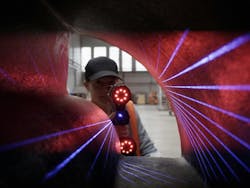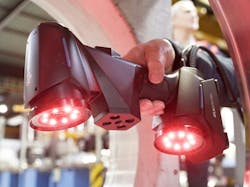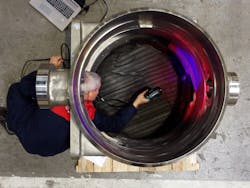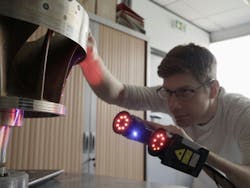Q&A: Advancing Metrology with Handheld 3D Scanners
Hexagon’s Manufacturing Intelligence Division offers handheld 3D scanning devices for flexibility and efficiency of measurement processes in a range of environments. The company’s ATLASCAN Max and MARVELSCAN are engineered with a vision system that helps meet the growing demand for digitalized 3D scans throughout the product life cycle. They enable engineers and manufacturing personnel to scan components in a range of inspection contexts.
Suitable for applications in automotive, rail, industrial equipment and general manufacturing, as well as heritage and restoration projects, the scanners are designed to be user-friendly and an essential tool for quality inspection and reverse engineering tasks.
To learn more about the scanners, Machine Design reached out to Joel Martin, director of product management, North America, at Hexagon.
Editor’s note: Questions and answers have been edited for space and clarity.
Machine Design: What are the key performance metrics that machine design engineers should consider when evaluating this 3D scanner?
Joel Martin: When evaluating a 3D scanner, machine design engineers should consider several key performance metrics to ensure they choose the right tool for their specific requirements, including:
- Speed—Efficiency in action and scanning speed impacts productivity. It’s not just about how many millions of points per second the scanner provides, it’s more about how well the technology fits the application. Users must ensure they’re able to respond quickly, complete measurement tasks without excessive prep work or setup and return acceptable results without time-consuming do-overs. Design engineers should identify what problems they are trying to solve and work with scanner manufacturers to make sure that the technology fits the need. Too often we see companies trying to solve a problem with the wrong technology because it is all that was available at the time.
- Agility—Users should be poised to measure whatever the design and engineering teams bring, shift to new tasks without disruption and be ready for the next big idea before it becomes reality. Look for a scanner with a suite of scanning tools to best fit the requirements as needs change.
- Simplicity—Reduce complexity wherever possible, get new workers trained and productive quickly and ensure the right resources are in place to complete the work the business expects. Scanners need to be easy to use and fit the application. If the technology is too complicated to use or set up, then its adoption will be limited in actual use.
MD: How easily can this scanner integrate into existing workflows?
JM: Hexagon’s new handheld scanners are designed to add value immediately. Because these scanners do not require complicated fixturing or special measuring environments and are battery-powered and completely wireless, designers can easily identify quality problems while they’re still in the design or prototyping stage or on the assembly line. Providing easier-to-use, more flexible quality inspection tools improves designer innovation and allows metrology and measurement to be more accessible.
MD: Are there any compatibility issues or specific requirements that machine design engineers should be aware of?
JM: It’s less about compatibility or specific requirements and more about choosing the right tool for the right job. Maybe even more important, finding a technology partner that will work as a consultant more than “just” a salesman. It’s critical to work with a company that can offer multiple solutions and isn’t just trying to solve a problem with one piece of “do-it-all” technology.
MD: What level of precision and accuracy can engineers expect from this 3D scanner, especially in complex industrial environments?
JM: Accuracy is the foundation of precision. It refers to the level of size error between the scanned data and the actual object. A highly accurate 3D scanner ensures that the captured measurements closely match the real-world dimensions of the object. Resolution (also known as point spacing), on the other hand, determines the spacing between individual points in the point cloud. Higher resolution allows for capturing intricate surface details with greater fidelity.
MD: Are there any limitations on considerations related to the accuracy of scanned data for machine design applications?
JM: Accuracy and resolution are independently important. There are many handheld technologies available today from hobby (0.5 mm) level scanners all the way to metrology grade (20 µm) scanners like the MARVELSCAN and ATLASCAN Max. It can also be important to understand what features need to be measured and if users want to extract those from the point cloud or if the sensor should measure them directly with vision or even a touch probe, like those found on portable coordinate measuring machines (CMMs).
MD: How does the use of this scanner enhance the efficiency of design processes for machine components or systems?
JM: Measurement should be meticulous; but, when the business is waiting for results, it’s imperative to be both meticulous and fast. Unfortunately, the process of scanning is, by its very nature, time consuming. Setting up the part and the scanner, positioning it properly, affixing and removing targets, and attaching and untangling cables, all add hours and cost to the process. And that’s before scanning begins, which brings a whole new level of potential complications and delays.
In addition to the time-consuming process of scanning, the usual process often ends with designers having to redo work if they don’t pass quality checks. The new handheld 3D scanners allow users to scan what is needed, where it’s needed, without restrictions, allowing design engineers to scan and ensure the quality of their product as they design it.
MD: Are there any features or functionalities that streamline the workflow for machine design engineers? Can you elaborate?
JM: MARVELSCAN allows for improved scanning speed and efficiency for parts and repetitive scanning applications. The patented Reverse Positioning System streamlines the workflow for design engineers by not having to take the time to place targets on an object. Instead, they can use an artifact in the environment to scan quickly and efficiently with no need for additional tracking devices, cables or connections.
MD: Can you provide insights on the potential ROI or cost savings that engineers can expect from using this technology effectively?
JM: Measure large parts—users can use the integrated photogrammetry system to easily extend the measurement volume of the scanner. There is no longer the need to worry about multiple measurement tools, as users can adapt to changing measurement needs on the fly, all with the simple scanner that is already in hand. And, when the scanner’s Galaxy Bar is included within the measurement area, better volumetric accuracy is secured, increasing measurement accuracy and speed on medium-sized parts by as much as 30%.
Measure features quickly and accurately, independent of scanning coverage—extracting features from points slows scanning down because it forces users to increase resolution and decrease speed. The MARVELSCAN automatically identifies where the feature is and measures it using vision, not a point cloud. As a result, features can be scanned more quickly and surfaces can be scanned as needed, decreasing inspection times by as much as 50%.
About the Author
Sharon Spielman
Technical Editor, Machine Design
As Machine Design’s technical editor, Sharon Spielman produces content for the brand’s focus audience—design and multidisciplinary engineers. Her beat includes 3D printing/CAD; mechanical and motion systems, with an emphasis on pneumatics and linear motion; automation; robotics; and CNC machining.
Spielman has more than three decades of experience as a writer and editor for a range of B2B brands, including those that cover machine design; electrical design and manufacturing; interconnection technology; food and beverage manufacturing; process heating and cooling; finishing; and package converting.
Email: [email protected]
LinkedIn: @sharonspielman
Facebook: Machine Design
YouTube: @MachineDesign-EBM





